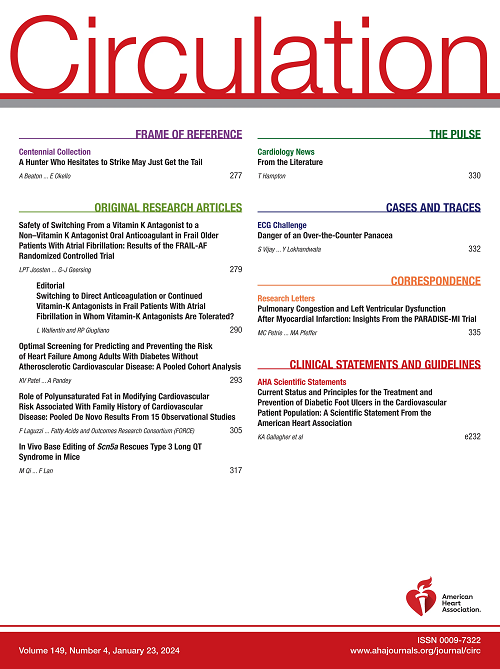TGF-β信号的成纤维细胞特异性缺失介导心肌梗死的脂肪瘤化生。
IF 38.6
1区 医学
Q1 CARDIAC & CARDIOVASCULAR SYSTEMS
引用次数: 0
摘要
背景:在存活的心肌梗死患者中,瘢痕内脂肪组织浸润是一种常见的病理发现,并被认为有助于功能障碍和心律失常的发生。然而,梗死后脂肪瘤化生的细胞机制仍然是谜。我们的研究揭示了一种新的分子机制,介导成纤维细胞到脂肪细胞的转化,并导致梗死心脏的脂肪浸润。方法生成TGF-β(转化生长因子β)或smad依赖性信号被成纤维细胞特异性破坏的smice和相应的对照,并进行再灌注和非再灌注心肌梗死治疗。超声心动图、组织学研究和转录组学分析用于研究对心脏修复和重塑的影响。谱系追踪实验用于记录成纤维细胞向脂肪细胞的转化。在体外,研究基因干扰或药物阻断TGF-β信号通路对小鼠心脏成纤维细胞的影响。分析了人类心肌梗死患者的单细胞RNA测序数据,以评估成纤维细胞向脂肪细胞的转化。结果通过TbR2(2型TGF-β受体)的缺失,TGF-β信号的特异性缺失增加了梗死后早期心脏破裂的发生率,促进了基质降解的成纤维细胞表型。此外,在再灌注和非再灌注梗死中,成纤维细胞特异性TbR2缺失导致30%至40%的成熟疤痕被脂肪细胞替代。谱系追踪表明,成纤维细胞特异性TbR2缺失通过与smad无关的级联反应促进成纤维细胞向脂肪细胞的转化。在体外,TbR2抑制诱导原代心脏成纤维细胞中脂肪生成相关基因的表达。遗传性TbR2缺失促进梗死成纤维细胞在促脂肪培养基刺激下转化为脂肪细胞。人类纤维化梗死心脏的成纤维细胞亚群获得脂肪细胞基因的表达。结论stgf -β信号在心脏损伤后成纤维细胞分化维持中起核心作用。TGF-β信号中断诱导成纤维细胞向脂肪细胞转化可能是疤痕相关脂肪瘤化生的基础,并可能在缺血性心肌病患者心力衰竭和心律失常的发病机制中发挥重要作用。本文章由计算机程序翻译,如有差异,请以英文原文为准。
Fibroblast-Specific Loss of TGF-β Signaling Mediates Lipomatous Metaplasia in the Infarcted Heart.
BACKGROUND
In patients surviving myocardial infarction, adipose tissue infiltration within the scar is a common pathological finding and has been suggested to contribute to dysfunction and arrhythmogenesis. However, the cellular mechanisms for lipomatous metaplasia after infarction remain enigmatic. Our study reveals a novel molecular mechanism that mediates fibroblast-to-adipocyte conversion and causes fatty infiltration in the infarcted heart.
METHODS
Mice with fibroblast-specific disruption of TGF-β (transforming growth factor β) or Smad-dependent signaling and corresponding controls were generated and underwent reperfusion and nonreperfusion myocardial infarction protocols. Echocardiography, histological studies, and transcriptomic analysis were used to study effects on cardiac repair and remodeling. Lineage tracing experiments were used to document fibroblast-to-adipocyte conversion. In vitro, the effects of genetic disruption or pharmacological blockade of TGF-β signaling on mouse cardiac fibroblasts were examined. Single-cell RNA sequencing data from human patients with myocardial infarction were analyzed to assess fibroblast-to-adipocyte conversion.
RESULTS
Fibroblast-specific abrogation of TGF-β signaling through deletion of TbR2 (type 2 TGF-β receptor) increased the incidence of early postinfarction cardiac rupture, promoting a matrix-degrading fibroblast phenotype. Moreover, fibroblast-specific TbR2 loss resulted in replacement of 30% to 40% of the mature scar with adipocytes in both reperfused and nonreperfused infarcts. Lineage tracing demonstrated that fibroblast-specific TbR2 loss promotes fibroblast-to-adipocyte conversion through effects that involve Smad-independent cascades. In vitro, TbR2 inhibition induced expression of adipogenesis-associated genes in primary cardiac fibroblasts. Genetic TbR2 loss promoted conversion of infarct fibroblasts to adipocytes upon stimulation with adipogenic medium. A subpopulation of fibroblasts in human fibrotic infarcted hearts acquired expression of adipocyte genes.
CONCLUSIONS
TGF-β signaling plays a central role in maintaining fibroblast cell specification after cardiac injury. Fibroblast-to-adipocyte conversion induced by disrupted TGF-β signaling may underlie scar-associated lipomatous metaplasia and may play an important role in the pathogenesis of heart failure and arrhythmogenesis in patients with ischemic cardiomyopathy.
求助全文
通过发布文献求助,成功后即可免费获取论文全文。
去求助
来源期刊

Circulation
医学-外周血管病
CiteScore
45.70
自引率
2.10%
发文量
1473
审稿时长
2 months
期刊介绍:
Circulation is a platform that publishes a diverse range of content related to cardiovascular health and disease. This includes original research manuscripts, review articles, and other contributions spanning observational studies, clinical trials, epidemiology, health services, outcomes studies, and advancements in basic and translational research. The journal serves as a vital resource for professionals and researchers in the field of cardiovascular health, providing a comprehensive platform for disseminating knowledge and fostering advancements in the understanding and management of cardiovascular issues.
 求助内容:
求助内容: 应助结果提醒方式:
应助结果提醒方式:


